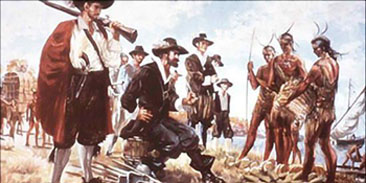Thank the Creator
for Every Day
By Roy Cook
Those people who became known as the Pilgrims were a group of people escaping religious persecution in England on a ridiculously small and overcrowded ship called the Mayflower by coming to America. When they arrived in Plymouth, many suffering from the ship-incubated scurvy disease and a very difficult Atlantic crossing, they soon realized that they were unprepared for the harsh winter and were facing starvation. Had it not been for the kindness and generosity of the Wampanoag Indians, they would not have survived. The Wampanoag and Samoset taught them to live off the land, to hunt and find food within nature’s bounty.


 The
Wampanoag fished in the fresh-water ponds and rivers for herring, trout,
perch, catfish and eels. They also fished in the saltwater ocean for cod,
tautog, pollock, bluefish, flatfish, bass, sea eels, mackerel and others.
The men even went out on whaling trips too! Women usually caught shellfish
such as oysters, soft-shelled clams, quahogs, mussels, razor clams, lobsters,
crabs, and conch. Many different kinds of nuts, berries, greens, and mushrooms
were gathered from the woods and other places. These were added to soups
and other dishes such as nasaump , a thick and filling food made of corn.
Some of these nuts and berries were eaten fresh, while others were dried
and stored for future use.
The
Wampanoag fished in the fresh-water ponds and rivers for herring, trout,
perch, catfish and eels. They also fished in the saltwater ocean for cod,
tautog, pollock, bluefish, flatfish, bass, sea eels, mackerel and others.
The men even went out on whaling trips too! Women usually caught shellfish
such as oysters, soft-shelled clams, quahogs, mussels, razor clams, lobsters,
crabs, and conch. Many different kinds of nuts, berries, greens, and mushrooms
were gathered from the woods and other places. These were added to soups
and other dishes such as nasaump , a thick and filling food made of corn.
Some of these nuts and berries were eaten fresh, while others were dried
and stored for future use.
 Additionally,
which leaves and herbs could alleviate discomfort and disease, though
to be fair, these early immigrants were oblivious to the virulent European
diseases they were exposing the native peoples to, or the deadly effect
they were going to have on the unsuspecting natives. Soon afterwards,
the Pilgrims, with no authority, and the Wampanoag would sign a treaty
of friendship. We know the mythical first Thanksgiving Day celebration
was exclusively a Plymouth affair taken part by the Pilgrims and the local
native Indians.
Additionally,
which leaves and herbs could alleviate discomfort and disease, though
to be fair, these early immigrants were oblivious to the virulent European
diseases they were exposing the native peoples to, or the deadly effect
they were going to have on the unsuspecting natives. Soon afterwards,
the Pilgrims, with no authority, and the Wampanoag would sign a treaty
of friendship. We know the mythical first Thanksgiving Day celebration
was exclusively a Plymouth affair taken part by the Pilgrims and the local
native Indians.
In the fall of 1621,
the Pilgrims had reason to celebrate. They had survived the winter and
applied the lessons of the Wampanoag, resulting in a bountiful autumn
harvest. The land had provided food for all and this alone was reason
for a public ceremony. The first Thanksgiving in the New World was hosted
by the Wampanoag in 1621. That feast was attended by 53 Pilgrims and 90
Native Americans, but contrary to tradition, bread, mashed potatoes and
gravy, sweet potatoes, stuffing, cranberry sauce and pumpkin pie were
not served, though wild turkey might have augmented the fish, eels, clams,
and venison, nuts, beans, corn, squash, and berries. The strict religious
colonists were not to incline to regularly celebrate thanksgiving. Much
more typical were days of prayer thanking God for blessings.
Geo. Washington, as the nation's first President, declared November 26,
1789, as a national day of "thanksgiving and prayer." A few
months after his inauguration, Washington issued "Presidential Proclamation
Number One", his Thanksgiving as the first President. He voiced his
personal conviction that "it is the duty of all Nations to acknowledge
the providence of Almighty God."
Thanksgiving as a
national holiday didn't see success until 1863 when Abraham Lincoln finally
made it a national holiday with his 1863 Thanksgiving Proclamation. So
it was Lincoln who resumed the tradition. And it has continued to the
present days. Probably the last Thursday of November was set by Lincoln
to somewhat correlate with the anchoring of the Mayflower at Cape Cod,
which occurred on November 21, 1620 as per the modern Gregorian calendar.
To the Pilgrims who used the Julian calendar it was November 11.
There is much to be thankful for each day. Every Dawn as it comes is a holy event and everyday is holy, for the light comes from "WAKAN-TANKA" Also you must remember that the Two-legged and all other peoples who stand upon this Earth are sacred and should be treated as a special part of creation.